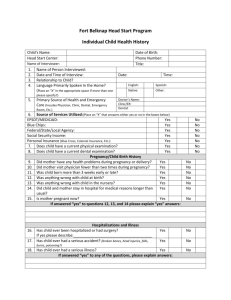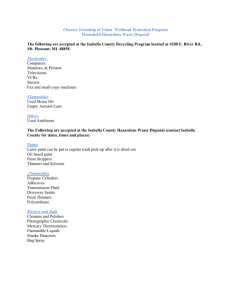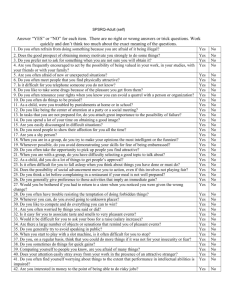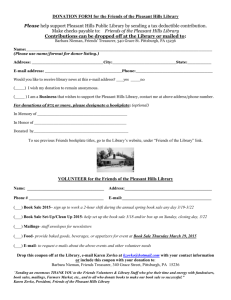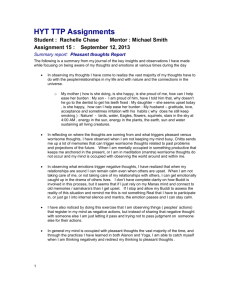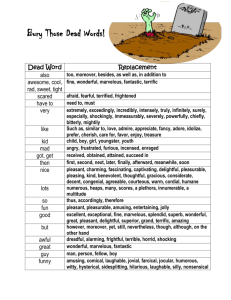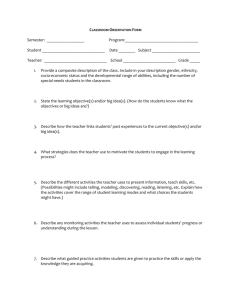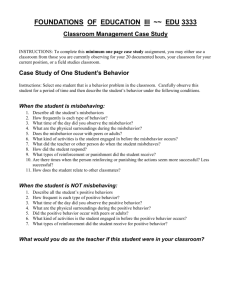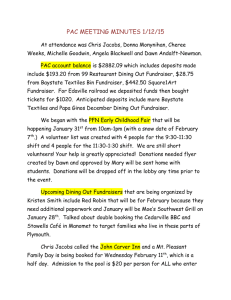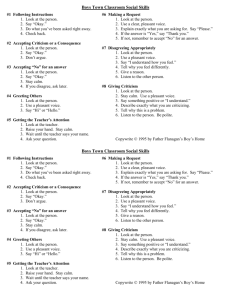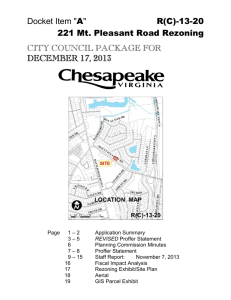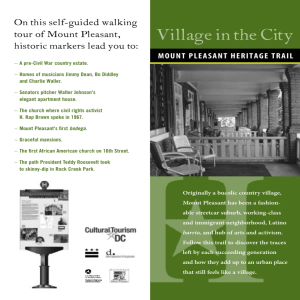teaching methods Chapter 5 Classroom Management
advertisement
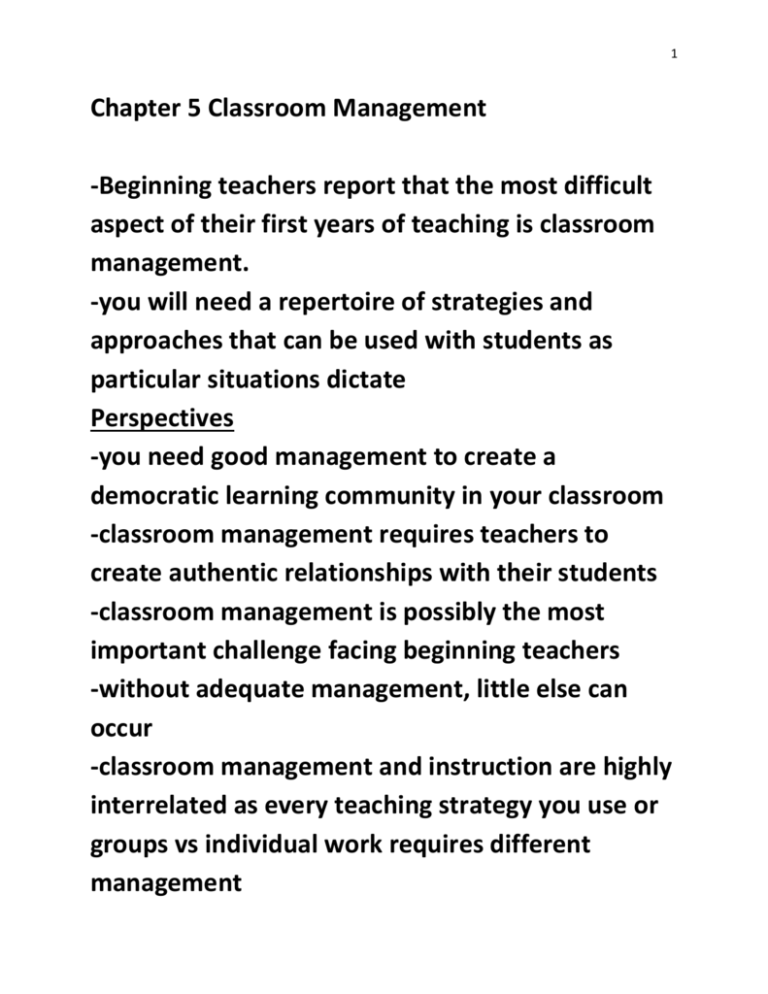
1 Chapter 5 Classroom Management -Beginning teachers report that the most difficult aspect of their first years of teaching is classroom management. -you will need a repertoire of strategies and approaches that can be used with students as particular situations dictate Perspectives -you need good management to create a democratic learning community in your classroom -classroom management requires teachers to create authentic relationships with their students -classroom management is possibly the most important challenge facing beginning teachers -without adequate management, little else can occur -classroom management and instruction are highly interrelated as every teaching strategy you use or groups vs individual work requires different management 2 Reinforcement theory -emphasizes the centrality of external events in directing behavior and the importance of positive and negative reinforcers -rewards can be in the form of grades, praise, and privileges to reinforce desired behaviors and punishments such as bad grades, reprimands, and loss of privileges to discourage undesirable tendencies or actions -a particular student’s classroom behavior rather than causes may stem from the features of the classroom group or teaching situation -there could be psychological causes such as insecurity, anxiety, need for attention Kounin’s research-ecology tradition -maybe is NOT the way the teachers disciplined their students that is important but instead the way the classroom as a group was managed that makes the difference Doyle and Carter’s research 3 -how are specific academic tasks are connected to student involvement and classroom management (students can get you to do the thinking for them by asking you questions ) Teaching research shows good behaviors 1.The more effective classroom managers had procedures that governed student talk, participation, movement, turning in work, and what to do on downtime 2.Laboratory and group activities in the effective classrooms ran smoothly as instructions were clear and student misbehavior was handled quickly 3.Effect managers give clear presentations and explanations and their direction about note taking were explicit Child centered traditions -no set of specific guidelines for achieving effective management and no recipes for teachers to follow -says that schools should be committed to a great moral purpose to care for children so that they too will be prepared to care 4 -caring and developing democratic classrooms become the alternative to preventative management and behavioral control Preventative classroom management 1.establish rules and procedures to prevent a large percentage of potential problems and disruptions 2.control student movement and make it move smoothly 3.control student talk by having a clear set of rules 4.downtime needs rules and procedures-don’t let there be idle time 5.teach students rules and procedures and make them routine 6.maintain consistency OR any set of rules and procedures quickly dissolves 7.prevent disruptive behavior with smoothness and momentum a.don’t dangle by starting an activity and then leaving it in midair(students hand in work but teacher forgot important part they still need to do) 5 b.don’t flip flop by having an activity that is started and then stopped while another is begun and then the original is started again c.don’t overdwell by going on and on when the instructions are clear to students d.don’t do fragmentation which is when you break activities into overly small units-tedious and irritating to kids 8.Be careful not to create classroom periods during unstable periods (last hour before homecoming football game full of football players is tough!) such as right before lunch or right after recess A.Open of class -great students at door to create positive feelings -train students to take roll, read announcements, ect.. -present instructions for students to do when they come in (bell activities) -establish routine and ceremonial events that communicate to students that serious work is to start 6 B.Transitions -do good planning and procedures -try cuing which are signaling systems to manage transistion D.closing class -leave time to complete closing activities such as a minute paper -assign homework early enough to clean up confusion or check for understanding before you start -establish routine for collecting work -use alert or cuing procedures to know when class if almost over(high school kids alert each other) -teach older students you dismiss NOT the buzzer or clock 9.develop student accountability -communicate assignments clearly and specify work requirements (rubrics are great) -have procedures for monitoring student work -be consistent in checking students’ completed work 7 -provide appropriate feedback on assignments Managing in appropriate and disruptive behavior 1.causes of behaviors -students find schoolwork boring and irrelevant so try to escape it -students’ out of school lives produce problems that play out in school -students are imprisoned in schools that have authoritarian feelings making kids want to rebel(I disagree with this one-we need strong school rules and leaders) -student rebelliousness and attention seeking are part of the growing-up process 2.dealing with misbehavior (beginning teachers should not look for causes but rather focus on the misbehavior and find a way to change it at least during the period of time the student is in the classroom) -have withitness (eyes in the back of your heads) -overlappingness-spot it and take care of it inconspicuously 8 -respond quickly 3.use reward to influence behavior by identifying desirable behaviors and identifying appropriate reinforcers 4.use praise 5.use rewards and privileges 6.use punishments and penalties Read Harry Wong’s First Day of School 9 Boys Town Social Skills *At Jefferson we utilize the Girls and Boys Town Social Skills Model for our discipline approach. This helps us create the positive, learning climate that our students deserve and allows us the teaching time we need to move in a timely fashion through our curricular agenda. *The students at our school will be treated with dignity and respect at all times. We, the adult community, will model respectful behavior for the students by speaking in calm voices, using appropriate proximity, maintaining pleasant facial expressions, and establishing and maintaining eye contact. *Classroom rules and consequences will be displayed in an obvious place in all classrooms. All procedures are consistent with the Girls and Boys Town Model. Many of the critical skills are listed here with the skill steps: 10 How to Greet 1. Look at the person 2. Use a pleasant voice tone 3. Smile 4. Make a verbal greeting How to Follow Directions 1. Look at the person 2. Say “OK” 3. Do the task immediately How to Accept Criticism 1. Look at the person 2. Say “OK” 3. No arguing, whining, pouting or complaining 11 How to Accept “No” 1. Look at the person 2. Say “OK” 3. No arguing, whining. pouting or complaining 4. If you want a reason, you may ask in a very polite, respectful tone How to Disagree Appropriately 1. Look at the person 2. Use a concern empathy statement 3. State specifically what you disagree with 4. Give reason for disagreeing 5. Thank person for listening How to Make a Request 1. Look at person 2. Use pleasant voice 3. State request specifically 4. Say, “Please” 5. Say “Thank you” if request granted 12 How to Apologize 1. Look at Person 2. Use pleasant voice tone 3. Make specific statement of remorse 4. State plan for future behavior 5. Ask person to accept apology How to Accept a Consequence 1. Look at person 2. Say “OK” 3. No arguing, whining, pouting or complaining How to Get Teacher’s Attention 1. Look at the teacher. 2. Raise your hand. 3. Wait quietly for acknowledgment. 4. State question/answer specifically. 13 How to Listen 1. Look at the person presenting. 2. Use pleasant face. 3. Sit straight. 4. Remain still and quietly listen. 5. Ask permission to talk if necessary How to Give Negative Feedback 1. Look at the person. 2. Make a praise/empathy statement. 3. State the problem/criticism. 4. Give a reason as to why it is a problem. 5. Give a possible solution. 6. Say “thank you”. 14 How to Stay on Task 1. Self start. 2. Work steadily for required time. 3. Sit straight and work quietly. 4. Remain awake. 5. Ignore distractions. 6. Maintain a pleasant face. 7. Ask for help when necessary. 15 Rules and Procedures Rules 1.For a positive classroom environment, we all must respect each other at all times. 2.To stay safe, do not bring food/pop into this classroom. A chemistry room is a dangerous place for food. 3.To be safe, happy, healthy, and out of trouble, ALWAYS follow Miss Tucek's instructions. 4. I only want to hear good reports from my sub. 5. To ensure all students are learning, cheating is not tolerated. When students work together, every student must turn in work that is in their own words. Procedures 1.Upon entering, find your seat IMMEDIATELY and begin the task posted. 2.If you need to leave the room, ask permission FIRST and sign out. Please don't forget to sign back in. 3.If you are not sure how to do a lab, ASK FIRST before doing anything. Consequences 1.Detentions, referrals, or verbal reprimands will be based on the severity of the situation. 2.Detentions will be served in a timely manner or an office referral will be issued. A forgotten detention will result in an office referral.
